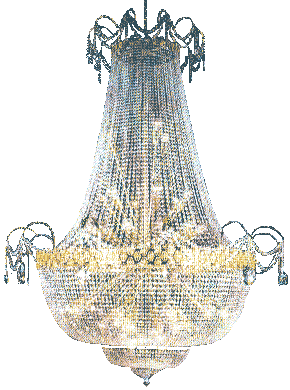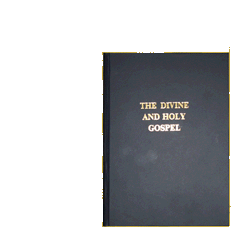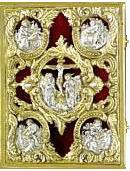|
The Orthodox Pages
THE DIVINE
AND HOLY GOSPEL
|
||||
|
For the Table of Gospels see below |
|
|||
|
|
Q. What is the Divine and Holy Gospel and how does it differ from the New Testament? A.
The
Holy Gospel is the Book wherein the Four Gospels of Matthew, Mark, Luke
and John are broken down into daily readings for the whole year. In
Orthodox Churches, the Holy Gospel is always kept on the Holy Altar,
usually with a go
For the Church, the Holy Gospel always represents Christ Himself; it is the written Image of the God-Man. Thus, in many of her services, the Book of the Holy Gospel is used to show the Very presence of Christ. To acknowledge the presence of Christ, it is needful to understand the very essence of time. In Genesis, we read that the heavens and the earth were created ‘in the beginning’. Time therefore began from the onset of creation, but there is an earthly time and a heavenly time, a temporal and a non-temporal. Earthly time is measured by change and motion. Its nature is to begin, to endure and to have an end. Heaven and the angels, exist outside of earthly time. They are not eternal, for they have a beginning, but have their existence ‘in the age’ [aeon, αιώνι], which according to St. Maximus is motionless time, for it remains without any change. God Himself, being uncreated, exists outside of time as we know it and outside of the aeon, for God has no beginning or end, but is eternal. The Church is not only the visible congregation worshipping here on earth, but also the invisible congregation of the saints and the angels worshipping in heaven. The Church visible on earth lives in complete communion and unity with the whole body of the Church of which Christ is the Head. It stands at a point of intersection where the past, present and future of our earthly existence are merged with the unchanging and motionless time of the aeon. All the events of Christ’s life, from His Birth to His Resurrection and Ascension, are re-acted by the Church, but they cease to be just an act and become a reality in that all the events are forever taking place in the motionless time of the Kingdom of heaven. Therefore, we become witnesses of His birth together with the wise men and the shepherds, we follow His earthly life, hearing His divine words of salvation and bear witness to the countless miracles He performed; we stand and gaze at His crucified body, in pain and disbelief that the Jews preferred the murderer Barrabas to Christ; and we become co-mourners with the Mother of God, the Apostles, the Myrrhbearers and all His followers; we follow Mary Magdalene and the Apostles to the empty tomb and rejoice with them at the news of the Resurrection. During the Divine Liturgy, the Priest raising the Gospel Book high and showing it to the people, carries it in Procession for the Little Entrance. At this point the Gospel symbolizes the first appearance of the Lord, when, while He Himself remained silent, was manifested by the Father. This first appearance we read of in the Gospel account of the Lord’s Baptism when, though He was still unknown to the multitude, the Father made Him manifest when He said, “This is my Beloved Son in whom I am well pleased”. The actual reading of the Gospel represents His more perfect manifestation, when He mingled with the crowd and made Himself known through His own words. Thus, Christ, through his Priests, continues His ministry, teaching, commanding and bestowing upon us His eternal words of salvation, even at this present time, as He taught the multitudes and His Apostles. During Sunday Mattins, after the reading of the Resurrection Morning Gospel, the Priest holding the Holy Gospel and showing the cover with the Resurrection, stands in the centre of the Church so that the people may venerate it. But it is not a book that the people venerate, for as Christ appeared to his disciples after His Resurrection, so now he appears among the people, and as St. Matthew tells us that after the resurrection “Jesus met them, saying, All hail. And they came and held him by the feet, and worshipped him.”[28: 9] so now the people come and worship Him. On Holy and Great [Good] Friday, the Gospel, together with the material Icon of the Entombment, is taken in procession and placed in the Sepulchre of the Epitaphios. Here, the Gospel is itself the image of the buried Christ and takes precedence over the material Icon. Thus, the people venerate first the Gospel Book and then the Icon of the Entombment. At the Easter Resurrection service, the Gospel is carried in procession around the Church and after the Gospel reading and the singing of ‘Christ is Risen’, is again carried into the Church. The procession around the Church is symbolic of Christ’s earthly life and the people following the procession are the multitudes that believed on Him and followed Him. The reading of the Gospel is the Good News of the Resurrection announced by the angel to the Myrrhbearers and the entering again into the Church is symbolic of Christ’s Ascension into Heaven, but at the same time it is also symbolic of Christ’s Second Coming when He shall judge both the quick and the dead and shall lead the faithful into the Kingdom of Heaven, the New Jerusalem, where they shall reign with him forever and ever. Amen.
The Prayer before the Gospel O Lord and lover of mankind: make the imperishable light of Thy divine knowledge to shine in our hearts; and open the eyes of our understanding that we may apprehend the preaching of Thy Gospel. Implant in us likewise awe of Thy blessed commandments, that trampling under feet all the lusts of the flesh we may pursue a spiritual life, thinking and doing always such things as are pleasing in Thy sight. For Thou art the enlightening of our souls and bodies, O Christ our God, and unto Thee we ascribe glory, together with Thine eternal Father and Thine all-holy, good and life-giving Spirit, now and for ever: world without end. Amen.
Click on a link to go to the Gospel Table The Moveable Cycle Note: The Daily Gospels Readings for the Moveable Cycle have no fixed date as the cycle begins with the Sunday of Easter which has a moveable date. The Holy Gospel According to St. John. The Holy Gospel According to St Matthew. The Holy Gospel According to St. Luke. The Holy Gospel According to St. Mark. The Sunday Morning Resurrection Gospels.
On Great Feasts of the Lord which have a fixed date, Feasts of the Mother of God and Feasts for certain Saints, the Gospel Reading from the Movable Cycle is replaced with a reading from the Immovable Cycle. Note that not all Saints have a special Gospel Reading assigned to them. On days where a Saint is celebrated and there is no Gospel Reading, the Reading is taken from the Movable Cycle or from the Common Gospel Readings according to the Rank of the Saint. (See Below) The Immovable Cycle The Gospels Readings For the Immovable Feasts of the Year and the Gospels Readings for certain Saints celebrated in each Month.
The Gospel Readings for the Various ranks of Saints
For the Bodiless Heavenly Hosts
Gospels for Various Occasions
Gospel on the Foundation of a Church Gospel at the Dedication [Consecration] of a Church Gospel at the Sacrament of Baptism Gospel at the Sacrament of Marriage Gospels at the Sacrament of Holy Unction For those who have Fallen Asleep [At the Funeral Service] † Another Gospel for the Departed † Another Gospel for the Departed † Another Gospel for the Departed † Another Gospel for the Departed For Infants that have Fallen Asleep Another especially for Women who have Confessed At Every Request and Supplication At the Start and Finish of School Lessons At the Start of Every Private Work At the Foundation of a School and other Buildings At the Inauguration Ceremony of the Establishment of a Municipal or Community Authority
|
|
||



